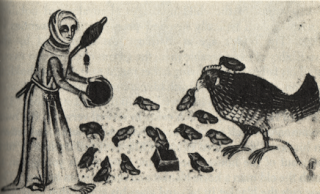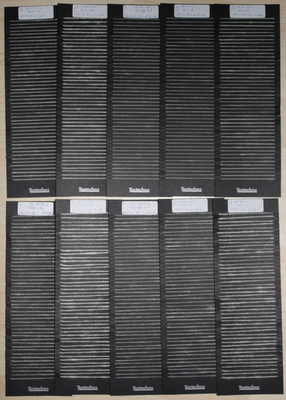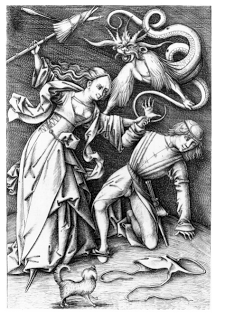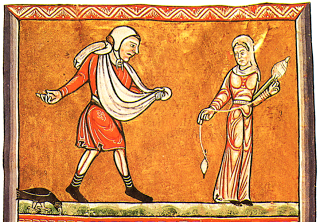There's another aspect to modern spinning - and "historical" hand-spindle spinning as it is done today - that has recently started to raise my neck hairs. It's a trap that most modern hand-spindle spinners fall into and do not ever get out of - mostly, I think, because they are not aware of it.
It is spinning without a distaff. When I learned how to spin, I did it on my own, knowing nothing of fibre prep and use of distaff. It's only quite recently, on the first Forum, that I actually met somebody who spins with a distaff as a rule and never without, and a second spinner (friends with the first) who pre-drafts her fibre to wear it around the wrist, thus having more or less the function of the distaff without the stick. Most spinners I know are just holding a piece of the fleece or top in their one hand, the upper drafting hand, and spin from there.
This has several negative effects. One, your hands are never perfectly dry, and you move your upper drafting hand when spinning - not much, perhaps, but you do. And as we all know, the combination of friction between fibres (movement), warmth and moisture leads to felt, not nice spinnable fibre; this means less quality in the thread as you near the end of your in-hand batch or a lot more prepared fibre thrown away - a huge waste of material and time. Two, you have to hold the batch of fibre in your upper hand, thus having two things to handle - the wool and the spinning. The wool in your hand does impede your movement a bit, and that might be the crucial bit - the reason why you are not spinning as regularly and evenly and fluidly as you could. Three, when you put away your spindle, the little batch of fibre attached to it can hang free and untwist the bit of thread between the spindle tip and itself. Four, you have to have an additional fibre supply if you do not want to mangle all the unwieldy stuff in your hand right away. Five, it is not historical (and that's a big deal to me).
These are all disadvantages that are as true for a spinner today as for a spinner of yore (well, except the last one, of course). So why are almost all modern spinners holding a wad of fibre in their hand? Probably because they learned to spin this way and never saw somebody using a distaff while their spinner-self was still young and malleable - and excited to try new things. But then, a distaff is so handy! And it doesn't even need to be so long. I am now working with a quite short tuck-under-the-arm distaff, and it is only 45 cm long. That is shorter than those distaffs depicted on medieval sources and those surviving completely in the archaeological records - which seem to be about 80-100 cm long at a rough estimate - but just long enough for me to tuck into the armpit and short enough to fit into my bags to take with me. Even shorter is also possible: a spare spindle stick can serve as a hand-held distaff like they were used in Roman times.
The difference between working with hand-held fibre and with non-hand-held fibre, whether it is fixed on a hand-held short distaff, on a underarm (or belt-held) medium or long distaff or wrapped around the wrist is enormous, especially for very fine yarns.* One, you don't felt your fibre, because you only pinch and do not hold. Two, your fibre is stored safely and out of your hand, thus impeding hand movement much less (this is less pronounced with the hand-held distaff). Three, when you use a medium to long, tuck-under distaff, you can turn the distaff with the spindle hanging on a short bit of yarn so that the upper spindle tip rests against your fibre on the distaff, thus keeping the spindle from turning backwards and untwisting the yarn. (Amazing, huh? And so easy! And it frees your hands, both of them, to do other chores, unless they require you stretching both arms. Might not work with extra-thin yarns and a heavy spindle, though.) Four, you can store a goodly-sized amount of fibre on your distaff, even on a hand-held one, to last you a while; so you can wander off and spin without taking a bag with extra fibre with you. And five, it looks like in the pictures.

Peasant woman feeding chicken; illumination from British Library MS Add. 42130, fol. 166v.
I have used a distaff once before, years ago, and already found then that it was a valuable tool, and that's long ago when my spinning was far from where it is today. And to this day, I'm not sure why I didn't stick with it; probably because I mostly spin for explanation and demonstration purposes and shied from taking the additional stick with me, and from taking it up and putting it down again. But now that I've finally seen the wonders of the distaff, I promise to amend my ways and to at least try to spin strictly historical from now on - and even more important, I promise to only teach new spinners to use spindle and distaff from now on.
So the next time you take up your spindle, try taking up a distaff with it. Pre-draft or diz your fibre top into a narrow band (the top as it is delivered is very wide and not really suitable for a distaff yet), or tear off a long narrow bit of your carded batt, wind it around a stick - any stick will do - and give it a try. And I'd be delighted to hear what you think!
* Personally, I prefer the medium length tucked under the arm; I can work with hand-helds, but my upper draft hand then tends to get cramped after a while, possibly because I have very small hands.
Picture source: Gies, F. and J. Gies (1999). Daily Life in Medieval Times. A vivid, detailed account of birth, marriage and death; food, clothing and housing; love and labor in the middle ages. New York, Black Dog & Leventhal Publishers.










